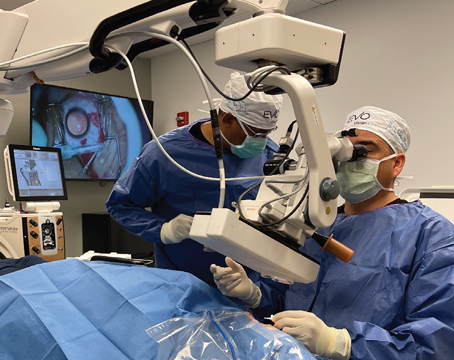Patient Presentation
Steven Wilson, MD, a surgeon at the Cleveland Clinic’s Cole Eye Institute, says he started to realize something was different about a small number of patients who were being referred to him. “I’ve only had three patients who I’ve thought had it,” he says. “They had been to three or four physicians and never seemed to be able to get relief. These were patients who seemed to have discomfort in their eyes that was way out of proportion to any of my findings in their eyes. There was no inflammation and the pain didn’t resolve after any existing dry eye was treated. They complained of a chronic aching in the eye, and also noted that the pain wasn’t intensified by pressing on the eye through the lid or any such tests.”
As Dr. Wilson alluded to, since some patients with LASIK-induced neurotrophic epitheliopathy, or LINE, can also have ocular discomfort, the clinician first has to rule out this condition when faced with a patient with chronic eye pain. “Most LINE patients don’t have eye pain,” he says. “Because, in most, the flap is numb until many months after the LASIK surgery. So, they may have a lot of punctate epithelial erosions on the surface of the cornea but not feel any discomfort whatsoever.
“However, what these LINE patients do have is fluctuating vision,” Dr. Wilson adds. “That’s the main symptom of LASIK-induced neurotrophic epitheliopathy. The patient with LINE may have a little discomfort at the flap edge where he still has some innervation, but it’s not this type of pain. This chronic, non-LINE pain that patients rarely complain of is very bothersome, and may even interfere with sleeping, for instance. These are the kinds of complaints that you just don’t hear with LINE.”
Solving the Problem
Dr. Wilson says his research into this type of pain makes him think it’s closer to complex regional pain syndrome, an entity that is known to strike anywhere in the body, and is more common after severe injuries. However, there appear to be some differences in CRPS in the eye vs. other locations.
“Chronic pain is more likely to occur not after surgery but after other trauma,” says pain specialist Michael Stanton-Hicks, MD, Dr. Wilson’s colleague at the Cleveland Clinic. “Probably 70 percent of such pain is related to nerve injury, either metabolic, traumatic or infective. The other major source of it in the United States is failed back surgery. It’s a completely different animal compared to acute pain, which is a normal physiologic response to some type of injury. Chronic pain is a total reset of the nervous system to a chronic focus on whatever the start of the pain was. If it continues for longer than three months, then it’s chronic.”
In Dr. Wilson’s LASIK patients, the cutting of the LASIK flap may have been enough trauma to touch off a chronic pain type of response. “I think it comes from some type of abnormal regeneration of the nerves that get cut when you make the LASIK flap,” he says. “In most patients, these nerves grow back perfectly normally; they may not have the same density in some people after their LASIK procedures, but they don’t have pain. But, in the very rare patient, for whatever reason, they get a chronic pain syndrome.”
|
However, in the rare patient with chronic pain, resolving the dry eye doesn’t help, and Dr. Wilson says that’s when you need to get a pain expert involved, in anticipation of starting more serious medications. “You basically will come to a point where you’ve gotten the dry eye better but the patient still has the ocular discomfort,” he says. “But they do respond to Neurontin, Lyrica or other medications in that class. When they begin to feel better with these drugs, that’s the best indication that you’ve got the right diagnosis of chronic pain.
“All three of the patients I treated required different dosages of pain medication,” Dr. Wilson adds. “That’s why, in my opinion, it’s important to get a pain management specialist involved, because he or she will be used to prescribing those types of medications. When the patient starts on one of these agents, you gradually increase it: You start with the minimum dose and the patient stays on it for several days; if he still has pain, you go a little higher on the dose. You keep increasing it until the pain is controlled, then stay at that dose.”
Dr. Wilson says that, though the drugs have been effective, there are some side effects to keep in mind. “These drugs do have some side effects, such as an increase in appetite that can lead to weight gain,” he says. “You can also have all kinds of anti-cholinergic symptoms such as GI distress or diarrhea, though none of the patients I treated successfully had any of those types of things.” REVIEW





